
Dynamic's of Cashew Nut Grades
Cashew Classification -Cashew Nut Grades - Cashews Grading Chart - Comprehensive Cashew Size Chart
The classification of cashew nuts into various grades is a critical aspect that profoundly influences market dynamics and the cashew industry. It is very important to have an understanding of cashew nut grades and the intricate factors that contribute to the categorization and subsequent market positioning of this versatile nut.
Cashew Classification - A Comprehensive Guide
This guide help you understand various aspects of cashew classification, offering insights into industry standards, grading criteria, and the sophisticated machinery involved in this crucial process. With a focus on size, color, and quality metrics, this comprehensive guide empowers stakeholders in the cashew industry, providing them with the knowledge needed to make informed decisions in procurement, ensuring product excellence, and meeting the evolving demands of the market. Whether you are a producer, buyer, or enthusiast in the cashew sector, this guide offers a nuanced understanding of the factors shaping the classification landscape, contributing to the overall quality and success of the industry.
Cashew Nut Grades
Grading involves the classification of the kernels based on colour, shape and size. Grading can be done manually, using highly-trained skilled labour or with cashew grading machines which can be obtained from different suppliers. Cashew kernels are graded into white (W), scorched (S) and desert (D) for colour and either whole (W) kernels or broken kernels for shape. Broken kernels are further graded by shape into splits (S), butts (B), pieces (P) and baby bits (BB). This is the classification scheme of the Association of Food Industries (AFI).
White Wholes
High-quality whole cashews that are light in color, often ranging from a pale ivory to a light golden hue.
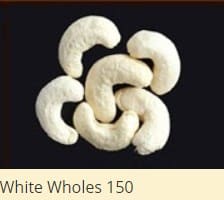
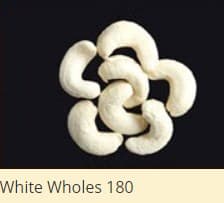
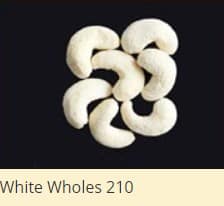

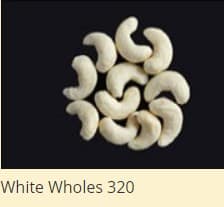
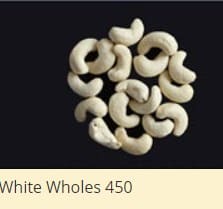
Scorched White Wholes
Scorched White Wholes are Cashew nuts that have undergone a slightly different processing method, resulting in a distinctive appearance and flavor.
- Processing Method: The term “scorched” indicates that the cashews have been subjected to a light roasting or heating process during processing.
- Color and Appearance: Scorched white wholes typically have a light to medium tan color, with a slightly roasted or scorched appearance. This gives them a unique visual appeal compared to the natural pale color of regular white wholes.
- Flavor Profile: The roasting process imparts a subtle, nutty flavor to the cashews, enhancing their taste and providing a distinct profile compared to raw or conventionally processed cashews.
- Texture: Despite the roasting, scorched white wholes are still whole cashews, maintaining their characteristic creamy texture.
Broken Cashew Nut Kernels
Broken kernels refer to a specific grade or category of cashew nuts that consists of pieces or fragments of cashew nuts that have been broken during processing. This grade is distinct from whole cashews and is characterized by its smaller, fragmented pieces.
Broken kernels are a natural outcome of the cashew processing cycle, where cashew nuts are separated from their shells and may break into smaller pieces.
Size and Appearance:
Broken kernels vary in size, ranging from small fragments to larger pieces. The appearance is characterized by irregular shapes and may include both halves and quarters of cashew nuts.
Uses:
Broken kernels are often used in culinary applications where the intact appearance of whole cashews is not crucial. They are commonly utilized in cooking, baking, and food processing, adding the rich flavor and texture of cashews to a variety of dishes.
Cost-Effectiveness:
Broken kernels are typically more cost-effective than whole cashews, making them an attractive option for manufacturers and processors who prioritize value while maintaining the flavor and nutritional benefits of cashews.
Applications:
Due to their smaller size and lower cost, broken kernels find applications in the food industry for products like snacks, confectionery, and bakery items. They are also used in the production of cashew butter or as ingredients in various culinary creations.
Packaging:
Broken kernels are usually packaged separately from whole cashews to meet the specific needs of consumers and businesses requiring this grade. Packaging may vary, and broken kernels are often available in bulk for industrial use or in smaller quantities for retail consumers.
Nutritional Value:
Despite being broken, the nutritional value of cashew kernels remains intact. They are a good source of healthy fats, protein, vitamins, and minerals.
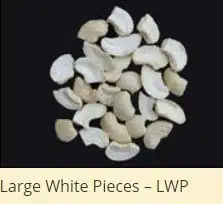
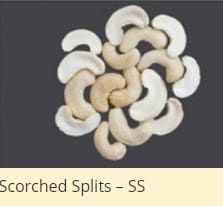

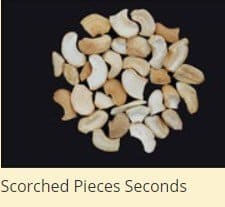
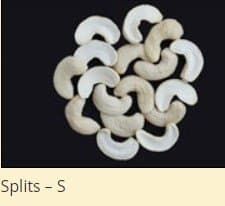


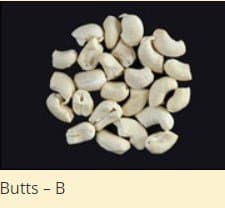

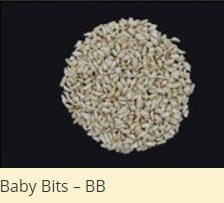
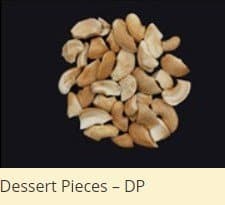
Grading of cashew kernels
| Grading Parameter | Grading Designation |
|---|---|
| Colour | White (W); Scorched (S); Dessert (D) |
| Shape | Whole (W); Broken kernels |
| Size | Whole: 140 – 500 – Broken kernels: e.g. splits (S), butts (B), pieces (P) and baby bits (BB) |
Classification based on Colour
Cashew kernels are also classified according to colour which is white (W), scorched
(S) or dessert (D). However, the colour classification also takes into account kernel
sizes which are whole or broken pieces.
| Grade | Color Characteristics |
|---|---|
| First Quality Fancy | Uniformly white, pale ivory or light yellow. |
| Second quality scorched | Yellow, light brown, light ivory, light ash-grey or deep ivory. |
| Third quality special scorched | Deep yellow, brown, amber, and light to deep blue. They may be slightly shrivelled, immature, and light-brown speckled, blemished or otherwise discoloured. |
| Fourth quality | They have the same colour characteristics as the first or second quality but have pitted spots. |
| Lightly blemished wholes (LBW) | Light brown, light ivory, light ash-grey or deep ivory. Kernels may show light brown speckles or blemishes on the surface, provided that not more than 40 % of the kernels are affected. |
| Lightly blemished pieces (LP) | They may be light brown, light ivory, light ash-grey or deep ivory. Pieces may show light brown speckles or blemishes on the surface, provided that not more than 20 % of the pieces are affected. |
| Blemished wholes (BW) | Deep yellow, brown, amber or light to deep blue. Kernels may be slightly shrivelled, immature or may be brown speckled or blemished on the surface, provided that not more than 60 % of the kernels are affected. |
| Dessert (D) | Cashew kernels may be scraped, deeply scorched, shrivelled, deep-brown-speckled, black-speckled, blemished or otherwise discolored. |
Classification based on Shape
Depending on their shape, cashew kernels are classified into whole and broken grades which are butts, splits or pieces as follows:
Conventional Grades of cashew kernels
| No. | Grade | Description |
|---|---|---|
| White Kernels | ||
| 1 | WW180 | White Wholes 180 |
| 2 | WW210 | White Wholes 210 |
| 3 | WW240 | White Wholes 240 |
| 4 | WW320 | White Wholes 320 |
| 5 | WW450 | White Wholes 450 |
| 6 | WW500 | White Wholes 500 |
| 7 | FB / WB | Fancy Butts (White Butts) |
| 8 | FS / WS | Fancy Splits (White Splits) |
| 9 | LWP | Large White Pieces |
| 10 | SWP | Small White Pieces |
| 11 | BB | Baby Bits |
| Scorched Kernels | ||
| 12 | SW180 | Scorched Wholes 180 |
| 13 | SW210 | Scorched Wholes 210 |
| 14 | SW240 | Scorched Wholes 240 |
| 15 | SW320 | Scorched Wholes 320 |
| 16 | SW450 | Scorched Wholes 450 |
| 17 | SW500 | Scorched Wholes 500 |
| 18 | SB | Scorched Butts |
| 19 | SS | Scorched Splits |
| 20 | SP | Scorched Pieces |
| 21 | SSP | Scorched Small Pieces |
| Dessert Kernels | ||
| 22 | DW | Dessert Wholes |
| 23 | SSW | Scorched Second Wholes |
| 24 | DB | Desert Butts |
| 25 | DS | Desert Splits |
| 26 | DP | Dessert Pieces |
| 27 | SPS | Scorched Pieces Second |
Cashew kernel sizes are classified in two broad categories:
Sizing of whole kernels includes ‘size count’ of 180, 210, 240, 320, 450 and less frequently 500. Note: the size count is the number of cashew kernels in 1 lb of cashew sample being considered. For the size grade 180, for example, the number of
kernels should ideally be 180 with an allowable range of below 180. That for size grade 210 is 181 to 210.
Sizing of broken kernels includes large and small kernels.
A combination of these sizing characteristics results in 27 conventional international
grades. However, there can be more than 27 grades depending on the country of
origin and market demand.
Classification Order
Grading cashew kernels is done in the order of colour, shape and size. A white coloured whole kernel in the size 180 will be referred to as WW180, meaning White, Whole, size 180. Another example of a grade is SW240, meaning Scorched,
Wholes, size 240.
However, few exceptions exist in the classification of broken kernels:
A white coloured butt is referred to as FB (fancy butts). Similarly, FS is referred to as fancy splits. Other exceptions are LWP (Large White Pieces) and SWP (Small White Pieces).
| Whole (W) | A cashew kernel is classified as whole if it has the characteristic kidney shape of a cashew kernel and not more than 1/8 of the kernel has been broken off. This grade is labelled as grade W. |
| Butts (B) | Butts are kernels which have been broken crosswise. They are less than 7/8 but not less than 3/8 of a whole kernel and the cotyledons are still naturally attached. This grade is labelled as grade B. |
| Splits (S) | Splits are kernels that have been split lengthwise and not more than 1/8 of its cotyledon has been broken off. This grade is labelled as S. |
| Pieces | Pieces are smaller size broken kernels. They are categorized into the following grades in a decreasing size order: • large pieces (LWP, SP, SPS, etc.) • small pieces (SWP, SSP, DSP, etc.) • chips (CHIPS, SSP1, SSP2, SSP3) • baby bits (BB, G1, G2, G3) • fine grains (X) • fines (FE) • mixed pieces (P1M, P2M, P3M) |
Size Grading: The Significance of Kernel Dimensions
One of the foundational elements in cashew nut grading is size. Cashews are categorized into different sizes based on the number of kernels per pound. This size classification holds substantial significance as it not only influences the visual appeal of the nut but also plays a crucial role in determining its market value. From jumbo cashews prized for their aesthetic appeal to smaller counterparts suitable for various culinary applications, understanding the nuances of size grading is paramount for industry buyers seeking precision in their procurement.
Color Spectrum: Aesthetic Considerations in Cashew Nut Grading
One of the foundational elements in cashew nut grading is size. Cashews are categorized into different sizes based on the number of kernels per pound. This size classification holds substantial significance as it not only influences the visual appeal of the nut but also plays a crucial role in determining its market value. From jumbo cashews prized for their aesthetic appeal to smaller counterparts suitable for various culinary applications, understanding the nuances of size grading is paramount for industry buyers seeking precision in their procurement.
Quality Metrics: Defects and Their Impact on Cashew Grades
Beyond size and color, the quality of cashew nuts is a paramount consideration in the grading process. Industry buyers must acquaint themselves with the intricate quality metrics that influence the categorization of cashews into different grades. Defects such as broken kernels, blemishes, or inconsistencies in shape are meticulously assessed, ensuring that only nuts meeting stringent quality standards make their way to the market. A thorough understanding of these quality metrics empowers industry buyers to make informed procurement decisions, aligning with their quality preferences and market positioning.
Market Dynamics: Aligning Procurement Strategies with Consumer Trends
Cashew nut grades are not only indicative of intrinsic qualities but also play a crucial role in shaping consumer choices. Industry buyers need to be attuned to market dynamics, understanding how different grades cater to diverse consumer preferences. From premium whole kernels favored by discerning snack enthusiasts to broken pieces sought after for culinary applications, the alignment of procurement strategies with consumer trends is essential for success in the cashew industry.
Frequently Asked Questions
A cashew is classified as a seed and fruit in one. Specifically, a cashew is the seed that grows outside of a cashew apple.
In more detail:
- The cashew apple is an oval or pear-shaped pseudofruit that grows on the cashew tree. This false fruit is juicy and can be used to make juices, jams, etc.
- Attached to the bottom of the cashew apple is the true fruit – the cashew seed. This seed is encased in a dense double shell with caustic phenolic resin in between the layers.
- The seed inside this shell is the edible cashew nut that can be extracted and consumed on its own after processing to remove the shell and resin.
So in botanical terms, the cashew “nut” is actually a seed. But it is different from other nuts because this seed develops outside the fruit, unlike almonds, walnuts etc where the seed is inside the fruit.
Cashews belong to the category of nuts. However, botanically speaking, cashews are actually seeds rather than true nuts.
Here’s a breakdown of how cashews are categorized:
Culinary Category:
- Cashews are culinarily categorized as nuts.
- They are used in recipes and eaten like typical tree nuts – almonds, walnuts, pecans, etc.
Botanical Category:
- Botanically, cashews are classified as seeds rather than true nuts.
- This is because the cashew “nut” is the seed of the cashew apple fruit.
- Other tree nuts have the seed inside the fruit, but cashews grow outside their fruits.
Plant Family Category:
- Cashews belong to the plant family Anacardiaceae.
- This family also contains mangos, pistachios, and poison ivy.
Commercial Category:
- Commercially, cashews are grouped with tree nuts for storage, shipping, and nutrition information.
- You’ll find cashews in the nuts section at the grocery store right alongside other nuts.
Cashews belong to the class Magnoliopsida. Specifically:
Kingdom: Plantae Division: Magnoliophyta Class: Magnoliopsida Order: Sapindales
Family: Anacardiaceae Genus: Anacardium Species: Anacardium occidentale
To break this down:
- Kingdom Plantae consists of all plant life.
- Division Magnoliophyta are angiosperms, or flowering plants.
- Class Magnoliopsida consists of dicotyledons, or plants with two seed leaves.
- Order Sapindales contains plants like maples, lychee, mangos, poison ivy, etc.
- Family Anacardiaceae specifically includes cashews, mangos, sumac, smoke trees, etc.
- Genus Anacardium are plants that bear their seeds on the outside.
- Species Anacardium occidentale is the scientific name for cashew plants.
Important Tags
Cashew nut grades requires a nuanced understanding of size, color, and quality classifications. Industry buyers seeking excellence in their procurement strategies should delve into the intricacies of these grades, recognizing the impact they have on market positioning and consumer choices. As the cashew industry continues to evolve, informed buyers armed with knowledge about cashew nut grades are well-equipped to make strategic decisions that not only meet consumer demands but also contribute to the overall growth and sustainability of this dynamic industry. cashew grades, cashew grade, scorched wholes, sieve, seeds, sw.
kernel cashew, raw cashew, nuts production, cashew allergy, cashew exports, cashew seeds, cashew tree, fruit, cashew apple, anacardium accidentale,
nuts, cashews, grade, cashew nuts, pieces, scorched, Cashew nut grades pdf Cashew nut grades chart, cashew grades chart pdf, Cashew nut grades and uses w180 cashew, cashew size chart, cashew nut grade and price, cashew kernels meaning
CONTACT FORM
We understand selecting the ideal cashew processing machinery is a crucial decision for your business. Filling our simple contact form will help us grasp your requirements accurately and suggest customized solutions for long-term efficiency gains. Our team will get in touch shortly to initiate the best pricing and features discussion for your upgrade needs.

